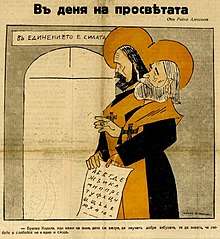Saints Cyril and Methodius
Cyril (born Constantine, 826–869) and Methodius (815–885) were two brothers and Byzantine Christian theologians and missionaries. For their work evangelizing the Slavs, they are known as the "Apostles to the Slavs".[6]
Saints Cyril and Methodius | |
|---|---|
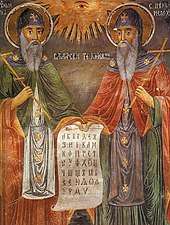 "Saints Cyril and Methodius holding the Cyrillic alphabet," a mural by Bulgarian iconographer Z. Zograf, 1848, Troyan Monastery | |
| Bishops and Confessors; Equals to the Apostles; Patrons of Europe; Apostles to the Slavs | |
| Born | 826 or 827 and 815 Thessalonica, Byzantine Empire (present-day Greece) |
| Died | 14 February 869 and 6 April 885 Rome and Velehrad, Moravia |
| Venerated in | Catholic Church Eastern Orthodox Church Anglican Communion[1] Lutheranism[2] |
| Feast | 11 and 24 May[3] (Orthodox Church) 14 February (present Roman Catholic calendar); 5 July (Roman Catholic calendar 1880–1886); 7 July (Roman Catholic calendar 1887–1969) 5 July (Roman Catholic Czech Republic and Slovakia) |
| Attributes | brothers depicted together; Eastern bishops holding up a church; Eastern bishops holding an icon of the Last Judgment.[4] Often, Cyril is depicted wearing a monastic habit and Methodius vested as a bishop with omophorion. |
| Patronage | Bulgaria, North Macedonia, Czech Republic, Slovakia, Transnistria, Archdiocese of Ljubljana, Europe,[4] Slovak Eparchy of Toronto, Eparchy of Košice[5] |
They are credited with devising the Glagolitic alphabet, the first alphabet used to transcribe Old Church Slavonic.[7] After their deaths, their pupils continued their missionary work among other Slavs. Both brothers are venerated in the Orthodox Church as saints with the title of "equal-to-apostles". In 1880, Pope Leo XIII introduced their feast into the calendar of the Roman Catholic Church. In 1980, Pope John Paul II declared them co-patron saints of Europe, together with Benedict of Nursia.[8]
Early career
Early life
The two brothers were born in Thessalonica (located in present-day Greece) – Cyril in about 827–828 and Methodius about 815–820. Cyril was reputedly the youngest of seven brothers; he was born Constantine,[9] but was given the name Cyril upon becoming a monk in Rome shortly before his death,[10][11][12] according to the Vita Cyrilli ("The Life of Cyril"). Methodius was born Michael and was given the name Methodius upon becoming a monk at Mysian Olympus (present-day Uludağ), in northwest Turkey.[13] Their father was Leo, a droungarios of the Byzantine theme of Thessalonica, and their mother was Maria.
The exact ethnic origins of the brothers are unknown, there is controversy as to whether Cyril and Methodius were of Slavic[14] or Byzantine Greek[15] origin, or both.[16] The two brothers lost their father when Cyril was fourteen, and the powerful minister Theoktistos, who was logothetes tou dromou, one of the chief ministers of the Empire, became their protector. He was also responsible, along with the regent Bardas, for initiating a far-reaching educational program within the Empire which culminated in the establishment of the University of Magnaura, where Cyril was to teach. Cyril was ordained as priest some time after his education, while his brother Methodius remained a deacon until 867/868.[17]
Mission to the Khazars
About the year 860, Byzantine Emperor Michael III and the Patriarch of Constantinople Photius (a professor of Cyril's at the University and his guiding light in earlier years), sent Cyril on a missionary expedition to the Khazars who had requested a scholar be sent to them who could converse with both Jews and Saracens.[18] It has been claimed that Methodius accompanied Cyril on the mission to the Khazars, but this may be a later invention. The account of his life presented in the Latin "Legenda" claims that he learned the Khazar language while in Chersonesos, in Taurica (today Crimea).
After his return to Constantinople, Cyril assumed the role of professor of philosophy at the University while his brother had by this time become a significant figure in Byzantine political and administrative affairs, and an abbot of his monastery.
The expedition of Cyril and Methodius is mentioned in Dictionary of the Khazars, the first novel of Milorad Pavić.
Mission to the Slavs
Great Moravia
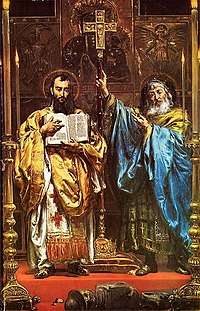
In 862, the brothers began the work which would give them their historical importance. That year Prince Rastislav of Great Moravia requested that Emperor Michael III and the Patriarch Photius send missionaries to evangelize his Slavic subjects. His motives in doing so were probably more political than religious. Rastislav had become king with the support of the Frankish ruler Louis the German, but subsequently sought to assert his independence from the Franks. It is a common misconception that Cyril and Methodius were the first to bring Christianity to Moravia, but the letter from Rastislav to Michael III states clearly that Rastislav's people "had already rejected paganism and adhere to the Christian law."[19] Rastislav is said to have expelled missionaries of the Roman Church and instead turned to Constantinople for ecclesiastical assistance and, presumably, a degree of political support.[20] The Emperor quickly chose to send Cyril, accompanied by his brother Methodius.[21] The request provided a convenient opportunity to expand Byzantine influence. Their first work seems to have been the training of assistants. In 863, they began the task of translating the Gospels and necessary liturgical books into the language now known as Old Church Slavonic[22] and traveled to Great Moravia to promote it.[23] They enjoyed considerable success in this endeavour. However, they came into conflict with German ecclesiastics who opposed their efforts to create a specifically Slavic liturgy.
For the purpose of this mission, they devised the Glagolitic alphabet, the first alphabet to be used for Slavonic manuscripts. The Glagolitic alphabet was suited to match the specific features of the Slavic language. Its descendant script, the Cyrillic, is still used by many languages today.[20]
The brothers wrote the first Slavic Civil Code, which was used in Great Moravia. The language derived from Old Church Slavonic, known as Church Slavonic, is still used in liturgy by several Orthodox Churches and also in some Eastern Catholic churches.
It is impossible to determine with certainty exactly what the brothers translated. The New Testament and the Psalms seem to have been the first, followed by other lessons from the Old Testament. The "Translatio" speaks only of a version of the Gospels by Cyril, and the "Vita Methodii" only of the "evangelium Slovenicum," though other liturgical selections may also have been translated.
Nor is it known for sure which liturgy, that of Rome or that of Constantinople, they took as a source. They may well have used the Roman alphabet, as suggested by liturgical fragments which adhere closely to the Latin type. This view is confirmed by the "Prague Fragments" and by certain Old Glagolitic liturgical fragments brought from Jerusalem to Kiev and discovered there by Izmail Sreznevsky—probably the oldest document for the Slavonic tongue; these adhere closely to the Latin type, as is shown by the words "Mass," "Preface," and the name of one Felicitas. In any case, the circumstances were such that the brothers could hope for no permanent success without obtaining the authorization of Rome.
Journey to Rome

The mission of Constantine and Methodius had great success among Slavs in part because they used the people's native language rather than Latin or Greek. In Great Moravia, Constantine and Methodius also encountered missionaries from East Francia, representing the western or Latin branch of the Church, and more particularly representing the Carolingian Empire as founded by Charlemagne, and committed to linguistic, and cultural uniformity. They insisted on the use of the Latin liturgy, and they regarded Moravia and the Slavic peoples as part of their rightful mission field.
When friction developed, the brothers, unwilling to be a cause of dissension among Christians, decided to travel to Rome to see the Pope, and seek a solution that would avoid quarreling between missionaries in the field. In 867, Pope Nicholas I (858-867) invited the brothers to Rome. Their evangelizing mission in Moravia had by this time become the focus of a dispute with Archbishop Adalwin of Salzburg (859–873) and Bishop Ermanrich of Passau (866-874), who claimed ecclesiastical control of the same territory and wished to see it use the Latin liturgy exclusively.
Travelling with the relics of Saint Clement and a retinue of disciples, and passing through Pannonia (the Balaton Principality), where they were well received by Prince Koceľ. This activity in Pannonia made a continuation of conflicts inevitable with the German episcopate, and especially with the bishop of Salzburg, to whose jurisdiction Pannonia had belonged for seventy-five years. As early as 865, Bishop Adalwin was found to exercise Episcopal rights there, and the administration under him was in the hands of the archpriest Riehbald. The latter was obliged to retire to Salzburg, but his superior was naturally disinclined to abandon his claims.
The brothers sought support from Rome, and arrived there in 868, where they were warmly received. This was partly due to their bringing with them the relics of Saint Clement; the rivalry with Constantinople as to the jurisdiction over the territory of the Slavs would incline Rome to value the brothers and their influence.[20]
New Pope Adrian II (867-872) gave Methodius the title of Archbishop of Sirmium (now Sremska Mitrovica in Serbia) and sent him back in 869, with jurisdiction over all of Moravia and Pannonia, and authorisation to use the Slavonic Liturgy. The brothers were praised for their learning and cultivated for their influence in Constantinople. Anastasius Bibliothecarius would later call Cyril "a man of apostolic life" and "a man of great wisdom".[24] Their project in Moravia found support from Pope Adrian II, who formally authorized the use of the new Slavic liturgy. Subsequently, Methodius was ordained as priest by the pope himself, and five Slavic disciples were ordained as priests (Saint Gorazd, Saint Clement of Ohrid and Saint Naum) and as deacons (Saint Angelar and Saint Sava) by the prominent bishops Formosus and Gauderic.[25] Cyril and Methodius along with these five disciples are collectively venerated (mainly by the Bulgarian Orthodox Church) as "Seven Saints".[26] The newly made priests officiated in their own languages at the altars of some of the principal churches. Feeling his end approaching, Cyril became a Basilian monk, was given the new name Cyril,[27] and died in Rome fifty days later (14 February 869). There is some question as to assertion of the Translatio (ix.) that he was made a bishop.
The statement of the "Vita" that Methodius was made bishop in 870 and not raised to the dignity of an archbishop until 873 is contradicted by the brief of Pope John VIII, written in June 879, according to which Adrian consecrated him archbishop; John includes in his jurisdiction not only Great Moravia and Pannonia, but Serbia as well.
Methodius alone
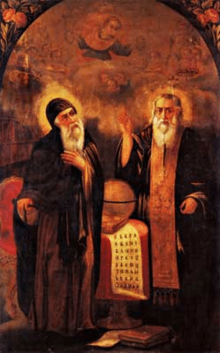
Methodius now continued the work among the Slavs alone; not at first in Great Moravia, but in Pannonia (in the Balaton Principality), owing to the political circumstances of the former country, where Rastislav had been taken captive by his nephew Svatopluk in 870, then delivered over to Carloman of Bavaria, and condemned in a diet held at Regensburg at the end of 870. A the same time, the East Frankish rulers and their bishops decided to remove Methodius. The archiepiscopal claims of Methodius were considered such an injury to the rights of Salzburg that he was captured and forced to answer to East Frankish bishops: Adalwin of Salzburg, Ermanrich of Passau, and Anno of Freising. After a heated discussion, they declared the deposition of the intruder, and ordered him to be sent to Germany, where he was kept prisoner in a monastery for two and a half years.[28]
In spite of the strong representations of the Conversio Bagoariorum et Carantanorum, written in 871 to influence the pope, though not avowing this purpose, Rome declared emphatically for Methodius, and sent a bishop, Paul of Ancona, to reinstate him and punish his enemies, after which both parties were commanded to appear in Rome with the legate. Thus in 873, new Pope John VIII (872-882) secured the release of Methodius, but instructed him to stop using the Slavonic Liturgy.[29]
Methodius' final years
The papal will prevailed, and Methodius secured his freedom and his archiepiscopal authority over both Great Moravia and Pannonia, though the use of Slavonic for the mass was still denied to him. His authority was restricted in Pannonia when after Koceľ's death the principality was administered by German nobles; but Svatopluk now ruled with practical independence in Great Moravia, and expelled the German clergy. This apparently secured an undisturbed field of operation for Methodius, and the Vita (x.) depicts the next few years (873–879) as a period of fruitful progress. Methodius seems to have disregarded, wholly or in part, the prohibition of the Slavonic liturgy; and when Frankish clerics again found their way into the country, and the archbishop's strictness had displeased the licentious Svatopluk, this was made a cause of complaint against him at Rome, coupled with charges regarding the Filioque.
In 878, Methodius was summoned to Rome on charges of heresy and using Slavonic. This time Pope John was convinced by the arguments that Methodius made in his defence and sent him back cleared of all charges, and with permission to use Slavonic. The Carolingian bishop who succeeded him, Witching, suppressed the Slavonic Liturgy and forced the followers of Methodius into exile. Many found refuge with Knyaz Boris of Bulgaria, under whom they reorganised a Slavic-speaking Church. Meanwhile, Pope John's successors adopted a Latin-only policy which lasted for centuries.
Methodius vindicated his orthodoxy at Rome, the more easily as the creed was still recited there without the Filioque, and promised to obey in regard to the liturgy. The other party was conciliated by giving him a Swabian, Wiching, as his coadjutor. When relations were strained between the two, John VIII steadfastly supported Methodius; but after his death (December 882) the archbishop's position became insecure, and his need of support induced Goetz to accept the statement of the Vita (xiii.) that he went to visit the Eastern emperor.
It was not until after Methodius' death, which is placed on 6 April 885,[30] that the animosity erupted into an open conflict. Gorazd, whom Methodius had designated as his successor, was not recognised by Pope Stephen V. The same Pope forbade the use of the Slavic liturgy[31] and placed the infamous Wiching as Methodius' successor. The latter exiled the disciples of the two brothers from Great Moravia in 885. They fled to the First Bulgarian Empire, where they were welcomed and commissioned to establish theological schools. There they and scholar Saint Clement of Ohrid[32] devised the Cyrillic script on the basis of the Glagolitic. Cyrillic gradually replaced Glagolitic as the alphabet of the Old Church Slavonic language, which became the official language of the Bulgarian Empire and later spread to the Eastern Slav lands of Kievan Rus'. Cyrillic eventually spread throughout most of the Slavic world to become the standard alphabet in the Eastern Orthodox Slavic countries. Hence, Cyril and Methodius' efforts also paved the way for the spread of Christianity throughout Eastern Europe.
Methodius' body was buried in the main cathedral church of Great Moravia. Until today it remains an open question which city was capital of Great Moravia and therefore the place of Methodius' eternal rest remains unknown.[33]
Invention of the Glagolitic and Cyrillic alphabets
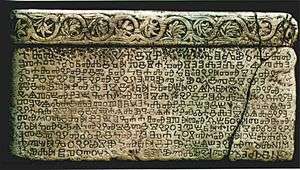
The Glagolitic and Cyrillic alphabets are the oldest known Slavic alphabets, and were created by the two brothers and their students, to translate the Gospels and liturgical books[22] into the Slavic languages.[34] The early Glagolitic alphabet was used in Great Moravia between 863 (the arrival of Cyril and Methodius) and 885 (the expulsion of their students) for government and religious documents and books, and at the Great Moravian Academy (Veľkomoravské učilište) founded by Cyril, where followers of Cyril and Methodius were educated, by Methodius himself among others. The alphabet has been traditionally attributed to Cyril. That attribution has been confirmed explicitly by the papal letter Industriae tuae (880) approving the use of Old Church Slavonic, which says that the alphabet was "invented by Constantine the Philosopher". The term invention need not exclude the possibility of the brothers having made use of earlier letters, but implies only that before that time the Slavic languages had no distinct script of their own.
The early Cyrillic alphabet was developed in the First Bulgarian Empire[35] and later finalized and spread by disciples Kliment and Naum in the Ohrid and Preslav schools of Tsar Boris I of Bulgaria[36] as a simplification of the Glagolitic alphabet which more closely resembled the Greek alphabet. It was developed by the disciples of Saints Cyril and Methodius at the Preslav Literary School at the end of the 9th century.
After the death of Cyril, Clement of Ohrid accompanied Methodius from Rome to Pannonia and Great Moravia. After the death of Methodius in 885, Clement headed the struggle against the German clergy in Great Moravia along with Gorazd. After spending some time in jail, he was expelled from Great Moravia, and in 885 or 886 reached the borders of the Bulgarian Empire together with Naum of Preslav, Angelarius, and possibly Gorazd (according to other sources, Gorazd was already dead by that time). The four of them were afterwards sent to the Bulgarian capital of Pliska, where they were commissioned by Tsar Boris I of Bulgaria to instruct the future clergy of the state in the Slavonic language.
After the adoption of Christianity in 865, religious ceremonies in Bulgaria were conducted in Greek by clergy sent from the Byzantine Empire. Fearing growing Byzantine influence and weakening of the state, Boris viewed the adoption of the Old Slavonic language as a way to preserve the political independence and stability of Bulgaria, so he established two literary schools (academies), in Pliska and Ohrid, where theology was to be taught in the Slavonic language. While Naum of Preslav stayed in Pliska working on the foundation of the Pliska Literary School, Clement was commissioned by Boris I to organise the teaching of theology to future clergymen in Old Church Slavonic at the Ohrid Literary School. For seven years (886-893) Clement taught some 3,500 students in the Slavonic language and the Glagolitic alphabet.
Commemoration
Saints Cyril and Methodius' Day
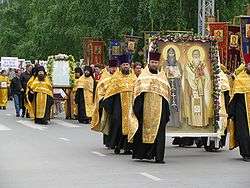
The canonization process was much more relaxed in the decades following Cyril's death than today. Cyril was regarded by his disciples as a saint soon after his death. His following spread among the nations he evangelized and subsequently to the wider Christian Church, and he was famous as a holy man, along with his brother Methodius. There were calls for Cyril's canonization from the crowds lining the Roman streets during his funeral procession. The brothers' first appearance in a papal document is in Grande Munus of Leo XIII in 1880. They are known as the "Apostles of the Slavs", and are still highly regarded by both Roman Catholic and Orthodox Christians. Their feast day is currently celebrated on 14 February in the Roman Catholic Church (to coincide with the date of St Cyril's death); on 11 May in the Eastern Orthodox Church (though for Eastern Orthodox Churches which use the Julian Calendar this is 24 May according to the Gregorian calendar); and on 7 July according to the old sanctoral calendar that existed before the revisions of the Second Vatican Council. The celebration also commemorates the introduction of literacy and the preaching of the gospels in the Slavonic language by the brothers. The brothers were declared "Patrons of Europe" in 1980.[37]
The first recorded secular celebration of Saints Cyril and Methodius' Day as the "Day of the Bulgarian script", as traditionally accepted by Bulgarian history, was held in the town of Plovdiv on 11 May 1851, when a local Bulgarian school was named "Saints Cyril and Methodius": both acts on the initiative of the prominent Bulgarian educator Nayden Gerov,[38] although an Armenian traveller mentioned his visit to the "celebration of the Bulgarian script" in the town of Shumen on 22 May 1803.[39]
The day is now celebrated as a public holiday in the following countries:
- In Bulgaria it is celebrated on 24 May and is known as the "Bulgarian Education and Culture, and Slavonic Script Day" (Bulgarian: Ден на българската просвета и култура и на славянската писменост), a national holiday celebrating Bulgarian culture and literature as well as the alphabet. It is also known as "Alphabet, Culture, and Education Day" (Bulgarian: Ден на азбуката, културата и просвещението). Saints Cyril and Methodius are patrons of the National Library of Bulgaria. There is a monument to them in front of the library. Saints Cyril and Methodius are the most celebrated saints in the Bulgarian Orthodox church, and icons of the two brothers can be found in every church.
- In North Macedonia, it is celebrated on 24 May and is known as the "Saints Cyril and Methodius, Slavonic Enlighteners' Day" (Macedonian: Св. Кирил и Методиј, Ден на словенските просветители), a national holiday. The Government of the Republic of Macedonia enacted a statute of the national holiday in October 2006 and the Parliament of the Republic of Macedonia passed a corresponding law at the beginning of 2007.[40] Previously it had only been celebrated in the schools. It is also known as the day of the "Solun Brothers" (Macedonian: Солунските браќа).
- In the Czech Republic and Slovakia, the two brothers were originally commemorated on 9 March, but Pope Pius IX changed this date to 5 July for several reasons.[41] Today, Saints Cyril and Methodius are revered there as national saints and their name day (5 July), "Sts Cyril and Methodius Day" is a national holiday in Czech Republic and Slovakia. In the Czech Republic it is celebrated as "Slavic Missionaries Cyril and Methodius Day" (Czech: Den slovanských věrozvěstů Cyrila a Metoděje); in Slovakia it is celebrated as "St. Cyril and Metod Day" (Slovak: Sviatok svätého Cyrila a Metoda).[41]
- In Russia, it is celebrated on 24 May and is known as the "Slavonic Literature and Culture Day" (Russian: День славянской письменности и культуры), celebrating Slavonic culture and literature as well as the alphabet. Its celebration is ecclesiastical (11 May in the Church's Julian calendar). It is not a public holiday in Russia.
The saints' feast day is celebrated by the Eastern Orthodox Church on 11 May and by the Roman Catholic Church and the Anglican Communion on 14 February as "Saints Cyril and Methodius Day". The Lutheran Churches of Western Christianity commemorate the two saints either on 14 February or 11 May. The Byzantine Rite Lutheran Churches celebrate Saints Cyril and Methodius Day on 24 May.[42]
Other commemoration
The national library of Bulgaria in Sofia, Ss. Cyril and Methodius University of Skopje in the North Macedonia, and St. Cyril and St. Methodius University of Veliko Tarnovo in Bulgaria and in Trnava, Slovakia, bear the name of the two saints. Faculty of Theology at Palacký University in Olomouc (Czech Republic), bears the name "Saints Cyril and Methodius Faculty of Theology". In the United States, SS. Cyril and Methodius Seminary in Orchard Lake, Michigan, bears their name.
The Brotherhood of Saints Cyril and Methodius (1846), a pro-Ukrainian organization in the Russian Empire to preserve Ukrainian national identity.
Saints Cyril and Methodius are the main patron saints of the Archdiocese of Ljubljana. Ljubljana Cathedral stands at Cyril and Methodius Square (Slovene: Ciril–Metodov trg).[43] They are also patron saints of the Byzantine Catholic Eparchy of Košice (Slovakia)[5] and the Slovak Greek Catholic Eparchy of Toronto.
St. Cyril Peak and St. Methodius Peak in the Tangra Mountains on Livingston Island, South Shetland Islands, in Antarctica are named for the brothers.
Saint Cyril's remains are interred in a shrine-chapel within the Basilica di San Clemente in Rome. The chapel holds a Madonna by Sassoferrato.
The Basilica of SS. Cyril and Methodius in Danville, Pennsylvania, (the only Roman Catholic basilica dedicated to SS. Cyril and Methodius in the world) is the motherhouse chapel of the Sisters of SS. Cyril and Methodius, a Roman Catholic women's religious community of pontifical rite dedicated to apostolic works of ecumenism, education, evangelization, and elder care.[44]
Gallery
- Cross Procession in Khanty-Mansiysk on Saints Cyril and Methodius Day in May 2006
- Inauguration of the monument to Saints Cyril and Methodius in Saratov on Slavonic Literature and Culture Day
 Thessaloniki - monument of the two Saints gift from the Bulgarian Orthodox Church
Thessaloniki - monument of the two Saints gift from the Bulgarian Orthodox Church Bulgaria - Statue of the two Saints in front of the SS. Cyril and Methodius National Library in Sofia
Bulgaria - Statue of the two Saints in front of the SS. Cyril and Methodius National Library in Sofia North Macedonia - The monument in Ohrid
North Macedonia - The monument in Ohrid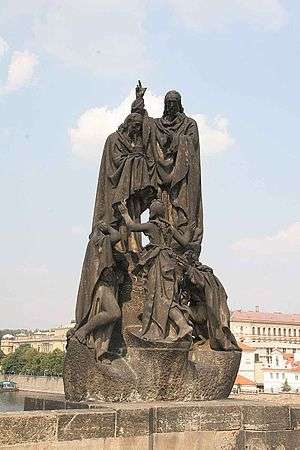
- Czech Republic - Saints Cyril and Methodius monument in Mikulčice
 Czech Republic - Statue of Saint Methodius at the Holy Trinity Column in Olomouc in Moravia
Czech Republic - Statue of Saint Methodius at the Holy Trinity Column in Olomouc in Moravia
 Russia - the monument in Khanty-Mansiysk
Russia - the monument in Khanty-Mansiysk
 Opening of Cyril and Methodius monument in Donetsk
Opening of Cyril and Methodius monument in Donetsk- Statue, Saints Cyril and Methodius, Třebíč, Czech Republic
Names in other languages
- Greek: Κύριλλος καὶ Μεθόδιος (Kýrillos kaí Methódios)
- Old Church Slavonic: Кѷриллъ и Меѳодїи
- Belarusian: Кірыла і Мяфодзій (Kiryła i Miafodzij) or Кірыла і Мятода (Kiryła i Miatoda)
- Bulgarian: Кирил и Методий (Kiril i Metodiy)
- Croatian: Ćiril i Metod
- Czech: Cyril a Metoděj
- Macedonian: Кирил и Методиј (Kiril i Metodij)
- New Church Slavonic: Кѷрі́ллъ и҆ Меѳо́дїй (Kỳrill" i Methodij)
- Russian: Кири́лл и Мефодий (Kirill i Mefodij), pre-1918 spelling: Кириллъ и Меѳодій (Kirill" i Methodij)
- Serbian: Ћирило и Методије / Ćirilo i Metodije
- Slovak: Cyril a Metod
- Slovene: Ciril in Metod
- Ukrainian: Кирило і Мефодій (Kyrylo i Mefodij)
See also
- Cyrillo-Methodian studies
- Brotherhood of Saints Cyril and Methodius
- Byzantine Empire
- Glagolitic alphabet
- SS. Cyril and Methodius Seminary
- SS. Cyril and Methodius University of Skopje
- SS. Cyril and Methodius National Library in Sofia
- St. Cyril and Methodius University of Veliko Tarnovo
- Saints Cyril and Methodius Faculty of Theology, Palacký University of Olomouc
- Saints Cyril and Methodius, patron saint archive
References
- "Holy Men and Holy Women" (PDF). Churchofengland.org.
- "Notable Lutheran Saints". Resurrectionpeople.org.
- In the 21st century this date in the Julian Calendar corresponds to 24 May in the Gregorian Calendar
- Jones, Terry. "Methodius". Patron Saints Index. Archived from the original on 19 February 2007. Retrieved 18 February 2007.
- History of the Eparchy of Košice Archived 22 December 2015 at the Wayback Machine (Slovak)
- "(PDF) Figures of (trans-) national religious memory of the Orthodox southern Slavs before 1945: an outline on the examples of SS. Cyril and Methodius". ResearchGate. Retrieved 15 November 2018.
- Liturgy of the Hours, Volume III, 14 February.
- "Egregiae Virtutis". Archived from the original on 4 January 2009. Retrieved 26 April 2009. Apostolic letter of Pope John Paul II, 31 December 1980 (in Latin)
- Cyril and Methodius, Encyclopædia Britannica 2005
- Vita Constantini slavica, Cap. 18: Denkschriften der kaiserl. Akademie der Wissenschaften 19, Wien 1870, p. 246
- Chapter 18 of the Slavonic Life of Constantine Archived 15 December 2012 at the Wayback Machine, an English translation
- English Translation of the 18th Chapter of the Vita Constantini, Liturgy of the Hours, Proper of Saints, 14 February
- "SS.Cyril and Methodius". www.carpatho-rusyn.org. Archived from the original on 17 March 2016. Retrieved 2 May 2018.
-
- 1. Mortimer Chambers, Barbara Hanawalt, Theodore Rabb, Isser Woloch, Raymond Grew. The Western Experience with Powerweb. Eighth Edition. McGraw-Hill Higher Education 2002. University of Michigan. p. 214. ISBN 9780072565447
- 2. Balkan Studies, Volume 22. Hidryma Meletōn Chersonēsou tou Haimou (Thessalonikē, Greece). The Institute, 1981. Original from the University of Michigan. p. 381
- 3. Loring M. Danforth. The Macedonian Conflict: Ethnic Nationalism in a Transnational World. Princeton University Press, 1995. p. 49 ISBN 9780691043562.
- 4. Ihor Ševčenko. Byzantium and the Slavs: In Letters and Culture'. Harvard Ukrainian Research Institute, 1991. p. 481. ISBN 9780916458126
- 5. Roland Herbert Bainton. Christianity: An American Heritage Book Series. Houghton Mifflin Harcourt, 2000. p. 156. ISBN 9780618056873
- 6. John Shea. Macedonia and Greece: The Struggle to Define a New Balkan Nation. McFarland, 1997. p. 56 . ISBN 9780786437672
- 7. UNESCO Features: A Fortnightly Press Service. UNESCO. United Nations Educational, Scientific and Cultural Organization, 1984. University of Michigan
- 8. The Pakistan Review, Volume 19. Ferozsons Limited, 1971. University of California. p. 41
- 9. Balkania, Volume 7. Balkania Publishing Company, 1973. Indiana University. p. 10
- 10. Bryce Dale Lyon, Herbert Harvey Rowen, Theodore S. Hamerow. A History of the Western World, Volume 1. Rand McNally College Pub. Co., 1974. Northwestern University. p. 239
- 11. Roland Herbert Bainton. The history of Christianity. Nelson, 1964. p. 169
- 12. Carl Waldman, Catherine Mason. Encyclopedia of European Peoples: Facts on File library of world history. Infobase Publishing, 2006. p. 752. ISBN 9781438129181
- 13. Frank Andrews. Ancient Slavs'. Worzalla Publishing Company, 1976. University of Wisconsin - Madison. p. 163.
- 14. Johann Heinrich Kurtz, John Macpherson. Church History. Hodder and Stoughton, 1891. University of California. p. 431
- 15. William Leslie King. Investment and Achievement: A Study in Christian Progress. Jennings and Graham, 1913. Columbia University.
-
- Columbia Encyclopedia, Sixth Edition. 2001–05, s.v. "Cyril and Methodius, Saints" "Greek missionaries, brothers, called Apostles to the Slavs and fathers of Slavonic literature."
- Encyclopædia Britannica, Major alphabets of the world, Cyrillic and Glagolitic alphabets, 2008, O.Ed. "The two early Slavic alphabets, the Cyrillic and the Glagolitic, were invented by St. Cyril, or Constantine (c. 827–869), and St. Methodius (c. 825–884). These men were Greeks from Thessalonica who became apostles to the southern Slavs, whom they converted to Christianity.
- Encyclopedia of World Cultures, David H. Levinson, 1991, p.239, s.v., "Social Science"
- Eric M. Meyers, The Oxford Encyclopedia of Archaeology in the Near East, p.151, 1997
- Lunt, Slavic Review, June 1964, p. 216; Roman Jakobson, Crucial problems of Cyrillo-Methodian Studies; Leonid Ivan Strakhovsky, A Handbook of Slavic Studies, p.98
- V.Bogdanovich, History of the ancient Serbian literature, Belgrade, 1980, p.119
- Hastings, Adrian (1997). The construction of nationhood: ethnicity, religion, and nationalism. Cambridge: Cambridge University Press. p. 126. ISBN 0-521-62544-0.
The activity of the brothers Constantine (later renamed Cyril) and Methodius, aristocratic Greek priests who were sent from Constantinople.
- Fletcher, R. A. (1999). The barbarian conversion: from paganism to Christianity. Berkeley, California: University of California Press. p. 327. ISBN 0-520-21859-0.
- Cizevskij, Dmitrij; Zenkovsky, Serge A.; Porter, Richard E. Comparative History of Slavic Literatures. Vanderbilt University Press. pp. vi. ISBN 0-8265-1371-9.
Two Greek brothers from Salonika, Constantine who later became a monk and took the name Cyril and Methodius.
- The illustrated guide to the Bible. New York: Oxford University Press. 1998. p. 14. ISBN 0-19-521462-5.
In Eastern Europe, the first translations of the Bible into the Slavonic languages were made by the Greek missionaries Cyril and Methodius in the 860s
- Smalley, William Allen (1991). Translation as mission: Bible translation in the modern missionary movement. Macon, Ga.: Mercer. p. 25. ISBN 978-0-86554-389-8.
The most important instance where translation and the beginning church did coincide closely was in Slavonic under the brothers Cyril and Methodius, with the Bible completed by A.D. 880. This was a missionary translation but unusual again (from a modern point of view) because not a translation into the dialect spoken where the missionaries were. The brothers were Greeks who had been brought up in Macedonia.
-
- 1. Philip Lief Group. Saintly Support: A Prayer For Every Problem. Andrews McMeel Publishing, 2003. p. 37. ISBN 9780740733369
- 2. UNESCO Features: A Fortnightly Press Service. United Nations Educational, Scientific and Cultural Organization., 1984. University of Michigan
- The Lives of the Ninth-Century Popes (Liber Pontificalis)– Google Knihy. Books.google.cz. 1 January 1995. ISBN 0-85323-479-5. Retrieved 24 December 2015.
- "Pope Benedict XVI. "Saints Cyril and Methodius", General Audience 17 June 2009, Libreria Editrice Vaticana". W2.vatican.va. Retrieved 29 January 2019.
- Vizantiiskoe missionerstvo, Ivanov S. A., Iazyki slavianskoi kul'tury, Moskva 2003, p. 147
- Encyclopædia Britannica, Cyril and Methodius, Saints, O.Ed., 2008
- "From Eastern Roman to Byzantine: transformation of Roman culture (500-800)". Indiana University Northwest. Archived from the original on 16 September 2017. Retrieved 31 August 2017.
- Abraham, Ladislas (1908). "Sts. Cyril and Methodius". The Catholic Encyclopedia. Robert Appleton Company. Retrieved 9 August 2020.
- "Sts. Cyril and Methodius". Pravmir. Archived from the original on 7 March 2012. Retrieved 31 August 2017.
- "Vir apostolicae vitae...sapientissimus vir" MGH Epist., 7/2, 1928, p. 436
- "Sv. Gorazd a spoločníci" [St. Gorazd and his colleagues]. Franciscan Friars of Slovakia (in Slovak). Archived from the original on 24 September 2015. Retrieved 27 August 2015.
- "Seven Saints". Kashtite.com. 27 July 2016. Retrieved 29 January 2019.
- As is customary, when one becomes a monk in the Eastern Orthodox tradition, one receives a new name.
- Bowlus 1995, p. 165-186.
- Goldberg 2006, p. 319-320.
- Житїе Меөодїя (Life of Methodius), title & chap. XVIII - available on-line Archived 5 March 2016 at the Wayback Machine
- Richard P. McBrien, Lives of the Popes, (HarperCollins, 2000), 144.
- "In Pictures: Ohrid, Home of Cyrillic". Balkan Insight. 24 May 2017. Retrieved 29 January 2019.
- Short Life of Cyril & Methodius. Translated by Ján STANISLAV: Životy slovanských apoštolov Cyrila a Metoda v legendách a listoch. Turčiansky Sv. Martin: Matica slovenská, 1950, p. 88. (Slovak)
- Encyclopædia Britannica, Major alphabets of the world, Cyrillic and Glagolitic alphabets, 2008, O.Ed. "The two early Slavic alphabets, the Cyrillic and the Glagolitic, were invented by St. Cyril, or Constantine (c. 827–869), and St. Methodius (c. 825–884). These men were Greeks from Thessalonica who became apostles to the southern Slavs, whom they converted to Christianity.
- Paul Cubberley (1996) "The Slavic Alphabets"
- Daniels and Bright, eds. The World's Writing Systems. Oxford University Press. ISBN 0-19-507993-0.
- "Nikolaos Martis: MACEDONIA". www.hri.org. Archived from the original on 2 May 2018. Retrieved 2 May 2018.
- "История на България", Том 6 Българско Възраждане 1856–1878, Издателство на Българската академия на науките, София, 1987, стр. 106 (in Bulgarian; in English: "History of Bulgaria", Volume 6 Bulgarian Revival 1856–1878, Publishing house of the Bulgarian Academy of Sciences, Sofia, 1987, page 106).
- Jubilee speech of the Academician Ivan Yuhnovski, Head of the Bulgarian Academy of Sciences, held on 23 May 2003, published in Information Bulletin Archived 3 December 2007 at the Wayback Machine of the Bulgarian Academy of Sciences, 3(62), Sofia, 27 June 2003 (in Bulgarian).
- Announcement about the eleventh session of the Government of the Republic of Macedonia on 24 October 2006 from the official site Archived 10 June 2008 at the Wayback Machine of the Government of the Republic of Macedonia (in Macedonian).
- Votruba, Martin. "Holiday date". Slovak Studies Program. University of Pittsburgh. Archived from the original on 14 May 2011. Retrieved 11 March 2009.
- "День Св. Кирила та Мефодія, просвітителів слов'янських" (in Ukrainian). Ukrainian Lutheran Church. 24 May 2014. Retrieved 19 September 2018.
- "The Ljubljana Metropolitan Province". 5 March 2014. Archived from the original on 5 March 2014.
- "Sisters of Saints Cyril and Methodius". Sscm.org. 4 March 2002. Archived from the original on 23 June 2013. Retrieved 14 June 2013.
Sources
- Bowlus, Charles R. (1995). Franks, Moravians, and Magyars: The Struggle for the Middle Danube, 788-907. Philadelphia: University of Pennsylvania Press.CS1 maint: ref=harv (link)
- Curta, Florin (2006). Southeastern Europe in the Middle Ages, 500–1250. Cambridge: Cambridge University Press.CS1 maint: ref=harv (link)
- Fine, John V. A., Jr. (1991) [1983]. The Early Medieval Balkans: A Critical Survey from the Sixth to the Late Twelfth Century. Ann Arbor, Michigan: University of Michigan Press. ISBN 0-472-08149-7.
- Goldberg, Eric J. (2006). Struggle for Empire: Kingship and Conflict under Louis the German, 817-876. Ithaca, NY: Cornell University Press.CS1 maint: ref=harv (link)
- Komatina, Predrag (2015). "The Church in Serbia at the Time of Cyrilo-Methodian Mission in Moravia". Cyril and Methodius: Byzantium and the World of the Slavs. Thessaloniki: Dimos. pp. 711–718.CS1 maint: ref=harv (link)
- Moravcsik, Gyula, ed. (1967) [1949]. Constantine Porphyrogenitus: De Administrando Imperio (2nd revised ed.). Washington D.C.: Dumbarton Oaks Center for Byzantine Studies.CS1 maint: ref=harv (link)
- Ostrogorsky, George (1956). History of the Byzantine State. Oxford: Basil Blackwell.CS1 maint: ref=harv (link)
- Vlasto, Alexis P. (1970). The Entry of the Slavs into Christendom: An Introduction to the Medieval History of the Slavs. Cambridge: Cambridge University Press.CS1 maint: ref=harv (link)

External links
| Wikimedia Commons has media related to Saints Cyril and Methodius. |
- Slavorum Apostoli by Pope John Paul II
- Cyril and Methodius – Encyclical letter (Epistola Enciclica), 31 December 1980 by Pope John Paul II
- Herbermann, Charles, ed. (1913). . Catholic Encyclopedia. New York: Robert Appleton Company.
- "Equal to Apostles SS. Cyril and Methodius Teachers of Slavs", by Prof. Nicolai D. Talberg
- Pope Leo XIII, "Grande munus: on Saints Cyril and Methodius
- Cyril and Methodius at orthodoxwiki
- Bulgarian Official Holidays, National Assembly of the Republic of Bulgaria: in English, in Bulgarian
- Bank holidays in the Czech Republic, Czech National Bank: in English, in Czech
- 24 May – The Day Of Slavonic Alphabet, Bulgarian Enlightenment and Culture
